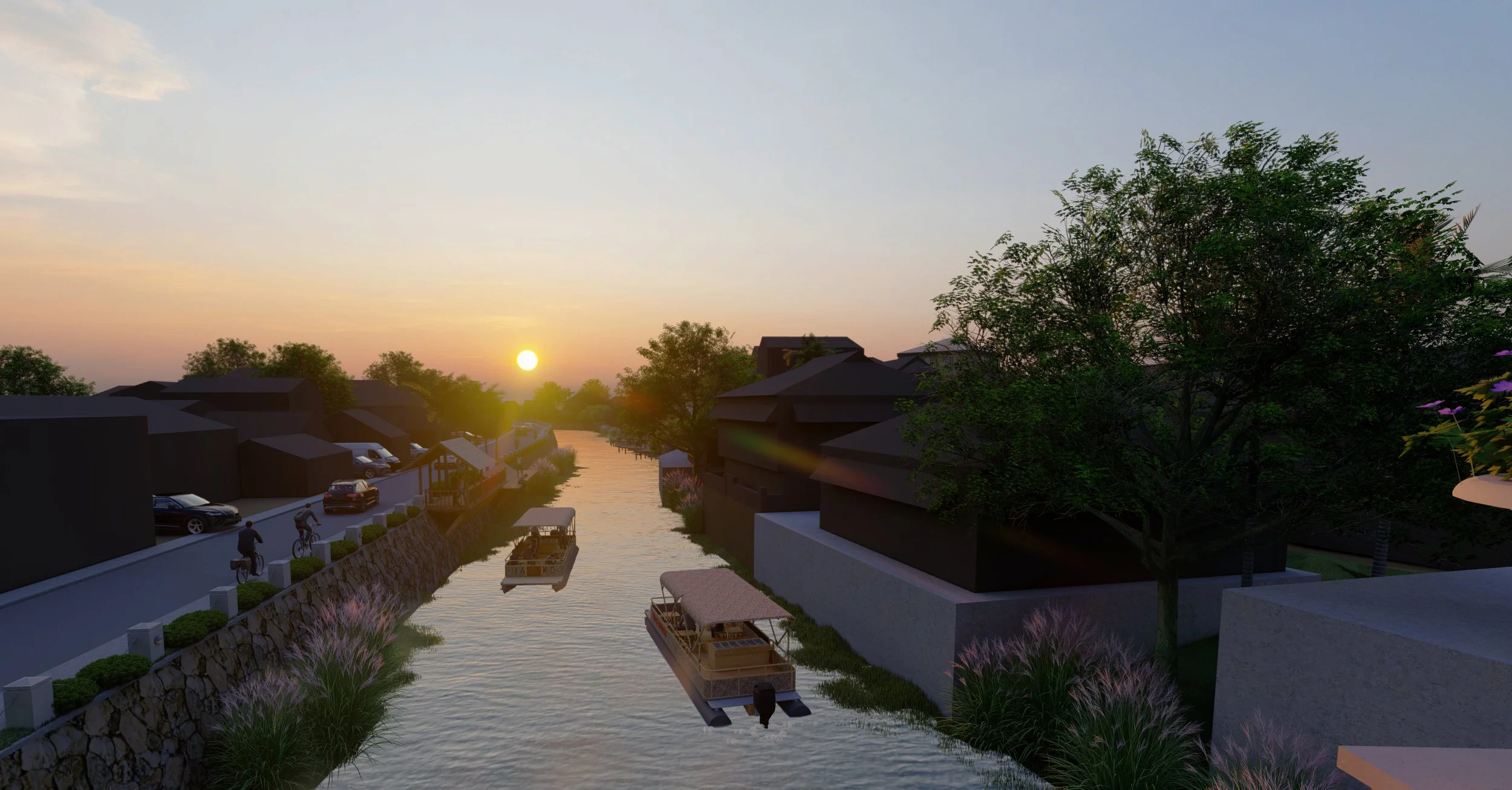Conservation as Reimagination: Navigating Pansipit River
by Jord Earving Gadingan
This article will use the term community to refer to both human and non-human lives existing within a place of cohabitation.
Pansipit River, the sole exit of Lake Taal waters to the Balayan Bay, a connecting pathway for fisherfolk since time immemorial. This river also welcomed the western world and is continuously shaped by a series of the Taal volcano unrests. The ecosystem had witnessed stories and species that pass through its waters.
Lake Taal enjoys Pansipit's vital ecological and hydrological support. Even so, Pansipit River receives smaller attention: fewer research, fewer policies and programs. With its services to the freshwater communities, the river is not an identified key freshwater ecosystem of conservation concern, though plans are being drafted to integrate it into the protected area management.
Threats on Pansipit and Pansipit as a Threat
I have seen the current state of the river through a clean up drive organized by the concerned local communities, right after a portion of the river had dried up due to some geological tilting.
Pansipit River appears as a threat to riverine communities due to its frequent flooding. Disaster mitigating measures on the flooding problem has always been to dredge the river bed which costs us millions of pesos. Indirect investments losses due to flood-disrupted economies are still unaccounted for.
The Taal Volcano unrest (2020) had dried up the end part of Pansipit River in Taal heritage town and exposed a heavily-silted river bed. A recent visit (2021) showed that Balayan Bay waves had narrowed Pansipit delta into a garbage-filled small outflow.
Sewage canals from households and establishments flow directly to the river. Backyard livestock keeping and conventional farming practices contribute to water quality deterioration. The riverbank is concreted without a green buffer. Water-related issues arise as towns are being more commercialized and developed.
Pansipit pockets on the river serves as a nursery for marine species from Balayan Bay, making themselves sturdier giving them a higher chance of survival in freshwater ecosystem life in Lake Taal.
Biodiversity richness of Pansipit also needs revisiting as marine species exchange was disrupted by the geophysical changes on the river. Fishing efforts showed tilapia, a non-native species, as the usual catch. Vegetation along the Pansipit is predominantly non-native species.
Rethinking of what runs on the river, Minimizing engine sound and water disturbances
Forgotten River, Drowned Memories
Not even this article can provide the solutions but we will try to explore possibilities and fantasies of regaining the Pansipit riverine integrity. As a community worker, I initially source and draft agendas with local fisherfolk and advocates through conversations about their relationship to the ecosystem.
Axel (28), a heritage advocate, grew up crossing the river when travelling from Taal to Lemery, the Pansipit in between, through a 3 peso-ride of a leaning boat in Brgy. Tatlong Maria.
“Neglection is real. It baffled me every time when people romanticized walking in the trash-filled river during the fluvial procession of the Our Lady of Caysasay. Why don't we take care of the river and be responsible for the trash? I have seen people tossing trash and directing their drainage system towards the river. Is it the government’s or the community’s accountability? It doesn’t make sense to me. With the recent volcanic eruption and river conditions, I worry about the band aid solutions. People should realize the historical and environmental significance of the river. I believe that the river could be a treasure chest of potentials for socio-cultural and green economic growth.”
RA (30), an architect who grew up in Taal heritage town recalls, “Pansipit River were my childhood memories and professional experiences as well. My fondest memory of the river is crossing it through Pansipit Bridge. As a child, I can’t help but be amazed by the other kids jumping and swimming in it (but my parents won’t allow me.) My grandparents live along Calle Ramon Diokno where I usually visit them during summer. Taunting it may seem but those were the days I saw people taking advantage of the waters and its flow. Yes, every morning, I saw children bathing while their moms were doing laundry on the riverside.”
On a field visit, I saw a sad old man sitting on a concrete blockade. Lolo Peping (63) is [was] a Taalenyo fisherfolk. He grew up along the Pansipit River, his house is situated just a few steps away from the river bank. During his childhood, he shared that they can’t even see the river bed in a dive, the river was too deep unlike now. He doesn’t need to become an environmental planner to say how the river got heavily silted as he pointed out the sewages of Lemery and water run off from the uptown Taal. “Now, it’s shallow.”
Lolo Peping was the only one I talked to that has been fishing in Lake Taal, Pansipit river and as far as the Balayan Bay and through the Verde Island Passage in Anilao, Mabini. “In Lake Taal, my usual catch are tawilis, tilapia, biya, dalag, bangus,” he enumerated ” while in Anilao, my usual catch are tamban, don pilas, galunggong – there’s a fishing port there to sell.” His average catch per day is 5 kilos using 200 string-and-hooks (pangangawil) or with his pana.
A lot of hesitation and scepticism on conservation is due to the belief that our culture is short-sighted and without an innate concept of sustainability. Also, green solutions are often anti-poor and perceived as anti-economic growth. These are on top of the fact that many are still less conscious of the river as a resource, and a service provider for the communities along with its flow. As a way of living becomes more and more commercially-industrially detached from the river.
One initiative we started is incubating Sa Ngalan ng Lawa (For the Sake of the Lake) which is a vision to co-create communities in co-existence. An initiative that takes root in Lake Taal embracing its complexities through the “other-sciences” approach to democratize the current conservation language and to design eco-literacy experiences.
One project is to set up an audio archive in Spotify for interviews and conversations on local knowledge of Lake Taal extending to the Pansipit River. The audio archive serves as a compendium for those who intend to do work with the ecosystems whether in biological and ecological sciences, public health, also stored manifesto readings and creative responses. Also, the initiative communicate local biodiversity observations of local communities in an Instagram platform and open for other perspectives. It is also important to note that these platforms are using the local language, Tagalog, which is seldom used in conservation communication and plan to reach out to those outside of the current conversations.
Pagsasagwan sa Pansipit [Navigating Pansipit] is a virtual field trip for local communities to bridge knowledge and awareness gaps in the ecosystem and aid in the degradation of near-ecological experiences.
Going Beyond Policies
All of these staged creative works hope to influence the current mindset that the river’s state is irreversible. We hope to give birth to a more inclusive environment programs and consultations as the pandemic situation ease up. A Participatory Pansipit River Environment Planning (PPREP) envisions to be drafted by multi-stakeholders to recognize the river as well as its biodiversity as an ecological corridor, disaster mitigation system, a natural heritage, a contribution to carbon banking and a livelihood and cultural asset.
A major shift in values and development measures are needed to be placed within the existing systems and it will take communities to drive that change. As a community worker and conservationist, if communities can adversely impact their environment, given a more informed and progressive perspective of a changing planet; they can be empowered also to act against these threats of degradations and extinctions.
“As a designer, I always look for the most holistic design. Every principle is interconnected, and finding a solution that caters to all aspects of well-being is how I approach planning developments. Consistently, I try to observe people’s interaction, natural elements, culture, among others with the area to be “developed.” All the information you get will help you approach the problem in a more grounded way,” from Axel.
“Comfort is within nature, only if you allow both nature and human co-exist in a community. However, this would be my initial list of key factors: Environmental Study – concerning the water characteristics and the form of life. Checking facts is the first thing one should do. Development Impact and Assessment – involving the community, culture and ways. Respecting the existing while introducing a new opportunity to progress. Design Consideration and Factors- not limited to layout planning, materials and appearance but mostly into a way to educate people of how to co-exist with it,” from RA.
“Before, if I had 2 kilos of catch, I can already secure us some kilos of rice, now it [Pansipit] has nothing,” then followed by an uncertain laugh. Now, his boat is stranded in the waterless Pansipit river in Taal. Lolo Peping is thriving through relief goods, his vegetable garden and occasional carpentry assignments. He remembered that during the violent 1965 eruption, Pansipit river did not dry up, this was the first time. “I hope that by the mercies of God that water will flow again on this side of the river,” prayed Lolo Peping.
These are just excerpts of longer talks and interviews. A lot of the pre-work of conservation is really the reimagination of reclaiming the freshwaters. Reclaiming in the sense of restoration of ecological health, ecosystem services and reintegration of community well-being on natural environs.
All statements, interviews and images are used with informed consent and permission © Axel Catapang, Lolo Peping and RA Garcia
Pansipit River Environment Designs © RA Garcia
About
Community and conservation nexus work interests Jord. He also do ecolitearture, organize and "trans-tell" local knowledge, and the initiative lead for Sa Ngalan ng Lawa. Sa Ngalan ng Lawa is consist of a pool of volunteers for Lake Taal ecosystem but more of a vision rather than a formalized organization; a vision to co-create communities in co-existence.






